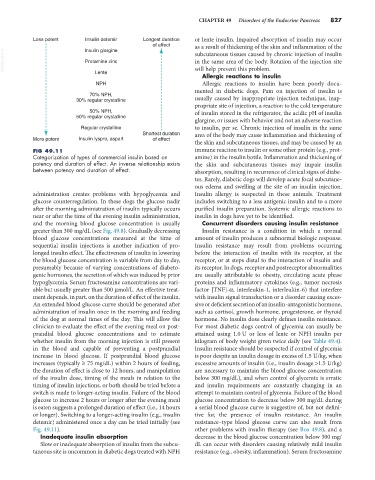Page 855 - Small Animal Internal Medicine, 6th Edition
P. 855
CHAPTER 49 Disorders of the Endocrine Pancreas 827
Less potent Insulin detemir Longest duration or lente insulin. Impaired absorption of insulin may occur
of effect as a result of thickening of the skin and inflammation of the
Insulin glargine
VetBooks.ir Protamine zinc subcutaneous tissues caused by chronic injection of insulin
in the same area of the body. Rotation of the injection site
will help prevent this problem.
Lente
Allergic reactions to insulin
NPH Allergic reactions to insulin have been poorly docu-
mented in diabetic dogs. Pain on injection of insulin is
70% NPH,
30% regular crystalline usually caused by inappropriate injection technique, inap-
propriate site of injection, a reaction to the cold temperature
50% NPH, of insulin stored in the refrigerator, the acidic pH of insulin
50% regular crystalline
glargine, or issues with behavior and not an adverse reaction
Regular crystalline to insulin, per se. Chronic injection of insulin in the same
Shortest duration area of the body may cause inflammation and thickening of
More potent Insulin lyspro, aspart of effect
the skin and subcutaneous tissues, and may be caused by an
FIG 49.11 immune reaction to insulin or some other protein (e.g., prot-
Categorization of types of commercial insulin based on amine) in the insulin bottle. Inflammation and thickening of
potency and duration of effect. An inverse relationship exists the skin and subcutaneous tissues may impair insulin
between potency and duration of effect. absorption, resulting in recurrence of clinical signs of diabe-
tes. Rarely, diabetic dogs will develop acute focal subcutane-
ous edema and swelling at the site of an insulin injection.
administration creates problems with hypoglycemia and Insulin allergy is suspected in these animals. Treatment
glucose counterregulation. In these dogs the glucose nadir includes switching to a less antigenic insulin and to a more
after the morning administration of insulin typically occurs purified insulin preparation. Systemic allergic reactions to
near or after the time of the evening insulin administration, insulin in dogs have yet to be identified.
and the morning blood glucose concentration is usually Concurrent disorders causing insulin resistance
greater than 300 mg/dL (see Fig. 49.8). Gradually decreasing Insulin resistance is a condition in which a normal
blood glucose concentrations measured at the time of amount of insulin produces a subnormal biologic response.
sequential insulin injections is another indication of pro- Insulin resistance may result from problems occurring
longed insulin effect. The effectiveness of insulin in lowering before the interaction of insulin with its receptor, at the
the blood glucose concentration is variable from day to day, receptor, or at steps distal to the interaction of insulin and
presumably because of varying concentrations of diabeto- its receptor. In dogs, receptor and postreceptor abnormalities
genic hormones, the secretion of which was induced by prior are usually attributable to obesity, circulating acute phase
hypoglycemia. Serum fructosamine concentrations are vari- proteins and inflammatory cytokines (e.g., tumor necrosis
able but usually greater than 500 µmol/L. An effective treat- factor [TNF]-α, interleukin-1, interleukin-6) that interfere
ment depends, in part, on the duration of effect of the insulin. with insulin signal transduction or a disorder causing exces-
An extended blood glucose curve should be generated after sive or deficient secretion of an insulin-antagonistic hormone,
administration of insulin once in the morning and feeding such as cortisol, growth hormone, progesterone, or thyroid
of the dog at normal times of the day. This will allow the hormone. No insulin dose clearly defines insulin resistance.
clinician to evaluate the effect of the evening meal on post- For most diabetic dogs control of glycemia can usually be
prandial blood glucose concentrations and to estimate attained using 1.0 U or less of lente or NPH insulin per
whether insulin from the morning injection is still present kilogram of body weight given twice daily (see Table 49.4).
in the blood and capable of preventing a postprandial Insulin resistance should be suspected if control of glycemia
increase in blood glucose. If postprandial blood glucose is poor despite an insulin dosage in excess of 1.5 U/kg, when
increases (typically ≥ 75 mg/dL) within 2 hours of feeding, excessive amounts of insulin (i.e., insulin dosage >1.5 U/kg)
the duration of effect is close to 12 hours, and manipulation are necessary to maintain the blood glucose concentration
of the insulin dose, timing of the meals in relation to the below 300 mg/dL), and when control of glycemia is erratic
timing of insulin injections, or both should be tried before a and insulin requirements are constantly changing in an
switch is made to longer-acting insulin. Failure of the blood attempt to maintain control of glycemia. Failure of the blood
glucose to increase 2 hours or longer after the evening meal glucose concentration to decrease below 300 mg/dL during
is eaten suggests a prolonged duration of effect (i.e., 14 hours a serial blood glucose curve is suggestive of, but not defini-
or longer). Switching to a longer-acting insulin (e.g., insulin tive for, the presence of insulin resistance. An insulin
detemir) administered once a day can be tried initially (see resistance–type blood glucose curve can also result from
Fig. 49.11). other problems with insulin therapy (see Box 49.8), and a
Inadequate insulin absorption decrease in the blood glucose concentration below 300 mg/
Slow or inadequate absorption of insulin from the subcu- dL can occur with disorders causing relatively mild insulin
taneous site is uncommon in diabetic dogs treated with NPH resistance (e.g., obesity, inflammation). Serum fructosamine

